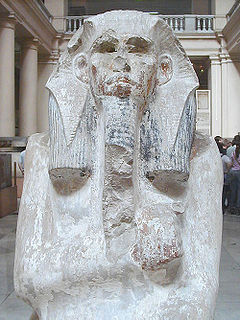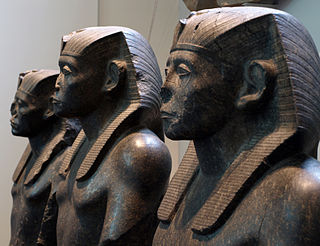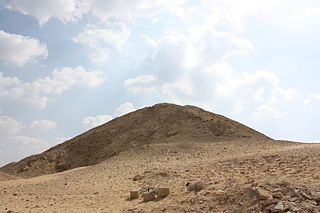Related Research Articles

Saqqara, also spelled Sakkara or Saccara in English, is an Egyptian village in Giza Governorate, that contains ancient burial grounds of Egyptian royalty, serving as the necropolis for the ancient Egyptian capital, Memphis. Saqqara contains numerous pyramids, including the Step pyramid of Djoser, sometimes referred to as the Step Tomb, and a number of mastaba tombs. Located some 30 km (19 mi) south of modern-day Cairo, Saqqara covers an area of around 7 by 1.5 km.

A mastaba, also mastabah, mastabat or pr-djt is a type of ancient Egyptian tomb in the form of a flat-roofed, rectangular structure with inward sloping sides, constructed out of mudbricks. These edifices marked the burial sites of many eminent Egyptians during Egypt's Early Dynastic Period and Old Kingdom. In the Old Kingdom epoch, local kings began to be buried in pyramids instead of in mastabas, although non-royal use of mastabas continued for over a thousand years. Egyptologists call these tombs mastaba, from the Arabic word مصطبة (maṣṭaba) "stone bench".

The pyramid of Djoser, sometimes called the Step Pyramid of Djoser, is an archaeological site in the Saqqara necropolis, Egypt, northwest of the ruins of Memphis. The 6-tier, 4-sided structure is the earliest colossal stone building in Egypt. It was built in the 27th century BC during the Third Dynasty for the burial of Pharaoh Djoser. The pyramid is the central feature of a vast mortuary complex in an enormous courtyard surrounded by ceremonial structures and decoration. Its architect was Imhotep, chancellor of the pharaoh and high priest of the god Ra.

Djoser was an ancient Egyptian pharaoh of the 3rd Dynasty during the Old Kingdom and the founder of this epoch. He is also known by his Hellenized names Tosorthros and Sesorthos. He was the son of king Khasekhemwy and queen Nimaathap, but whether he also was the direct throne successor is still unclear. Most Ramesside king lists name a king Nebka before him, but since there are still difficulties in connecting that name with contemporary Horus names, some Egyptologists question the received throne sequence. Djoser is known for his step pyramid, the earliest colossal stone building in ancient Egypt.

Amenemhat III, also known as Amenemhet III, was a pharaoh of ancient Egypt and the sixth king of the Twelfth Dynasty of the Middle Kingdom. He was elevated to throne as co-regent by his father Senusret III, with whom he shared the throne as the active king for twenty years. During his reign, Egypt attained its cultural and economic zenith of the Middle Kingdom.

The Egyptian pyramids are ancient masonry structures located in Egypt. Sources cite at least 118 identified "Egyptian" pyramids. Approximately 80 pyramids were built within the Kingdom of Kush, now located in the modern country of Sudan. Of those located in modern Egypt, most were built as tombs for the country's pharaohs and their consorts during the Old and Middle Kingdom periods.

Sobekneferu or Neferusobek was a pharaoh of ancient Egypt and the last ruler of the Twelfth Dynasty of the Middle Kingdom. She ascended to the throne following the death of Amenemhat IV, possibly her brother and husband, though their relationship is unproven. Instead, she asserted legitimacy through her father Amenemhat III. Her reign lasted 3 years, 10 months, and 24 days, according to the Turin King List.

Khakheperre Senusret II was the fourth pharaoh of the Twelfth Dynasty of Egypt. He ruled from 1897 BC to 1878 BC. His pyramid was constructed at El-Lahun. Senusret II took a great deal of interest in the Faiyum oasis region and began work on an extensive irrigation system from Bahr Yussef through to Lake Moeris through the construction of a dike at El-Lahun and the addition of a network of drainage canals. The purpose of his project was to increase the amount of cultivable land in that area. The importance of this project is emphasized by Senusret II's decision to move the royal necropolis from Dahshur to El-Lahun where he built his pyramid. This location would remain the political capital for the 12th and 13th Dynasties of Egypt. The king also established the first known workers' quarter in the nearby town of Senusrethotep (Kahun).

Khakaure Senusret III was a pharaoh of Egypt. He ruled from 1878 BC to 1839 BC during a time of great power and prosperity, and was the fifth king of the Twelfth Dynasty of the Middle Kingdom. He was a great pharaoh of the Twelfth Dynasty and is considered to be, perhaps, the most powerful Egyptian ruler of the dynasty. Consequently, he is regarded as one of the sources for the legend about Sesostris. His military campaigns gave rise to an era of peace and economic prosperity that reduced the power of regional rulers and led to a revival in craftwork, trade, and urban development. Senusret III was among the few Egyptian kings who were deified and honored with a cult during their own lifetime.

Abusir is the name given to an Egyptian archaeological locality – specifically, an extensive necropolis of the Old Kingdom period, together with later additions – in the vicinity of the modern capital Cairo. The name is also that of a neighbouring village in the Nile Valley, whence the site takes its name. Abusir is located several kilometres north of Saqqara and, like it, served as one of the main elite cemeteries for the ancient Egyptian capital city of Memphis. Several other villages in northern and southern Egypt are named Abusir or Busiri. Abusir is one relatively small segment of the extensive "pyramid field" that extends from north of Giza to below Saqqara. The locality of Abusir took its turn as the focus of the prestigious western burial rites operating out of the then-capital of Memphis during the Old Kingdom 5th Dynasty. As an elite cemetery, neighbouring Giza had by then "filled up" with the massive pyramids and other monuments of the 4th Dynasty, leading the 5th Dynasty pharaohs to seek sites elsewhere for their own funerary monuments.

Hemiunu was a man who lived in ancient Egypt, and who is believed to have been the architect of the Great Pyramid of Giza. As vizier, succeeding his father, Nefermaat, and his uncle, Kanefer, Hemiunu was one of the most important members of the court and responsible for all the royal works. His tomb lies close to Khufu's pyramid.

The pyramid of Teti is a smooth-sided pyramid situated in the pyramid field at Saqqara in Egypt. It is the second known pyramid containing pyramid texts. Excavations have revealed a satellite pyramid, two pyramids of queens accompanied by cult structures, and a funerary temple. The pyramid was opened by Gaston Maspero in 1882 and the complex explored during several campaigns ranging from 1907 to 1965. It was originally called Teti's Places Are Enduring. The preservation above ground is very poor, and it now resembles a small hill. Below ground the chambers and corridors are very well preserved.

The Black Pyramid was built by King Amenemhat III during the Middle Kingdom of Egypt. It is one of the five remaining pyramids of the original eleven pyramids at Dahshur in Egypt. Originally named Amenemhet is Mighty, the pyramid earned the name Black Pyramid for its dark, decaying appearance as a rubble mound. The Black Pyramid was the first to house both the deceased pharaoh and his queens. Jacques de Morgan, on a French mission, began the excavation on the pyramids at Dahshur in 1892. The German Archaeological Institute of Cairo completed excavation in 1983.

Khnumhotep III was an ancient Egyptian high steward and vizier of the 12th Dynasty.

Ptahshepses was the vizier and son-in-law of the Fifth Dynasty pharaoh Nyuserre Ini. As such he was one of the most distinguished members of the royal court. Ptahshepses' mastaba complex in Abusir is considered by many to be the most extensive and architecturally unique non-royal tomb of the Old Kingdom.

Siese was a vizier and treasurer of the Twelfth Dynasty of Egypt. He was most likely in office under Senusret III.
Sobekemhat was an ancient Egyptian treasurer under the king Senusret III in the Twelfth Dynasty. Sobekemhat is only known from his mastaba excavated in 1894 next to the pyramid of Senusret III at Dahshur. The mastaba was decorated on the outside with reliefs. These were only found in small fragments, but the fragments record the name and the titles of Sobekemhat. On an offering table he bears the title of the treasurer. The mastaba is in a chain of three mastabas, north of the king's pyramid. It is closest to the pyramid. The next mastaba belongs to the vizier (Nebit) and the third to another high official, perhaps again a vizier. Therefore, it can be argued that Sobekemhat's tomb was the earliest of the three. For a long time it was thought that Sobekemhat was vizier, but the relief fragments with the vizier's title come from the mastaba of Nebit nearby.

The pyramid of Senusret III is an ancient Egyptian pyramid located at Dahshur and built for pharaoh Senusret III of the 12th Dynasty.

Mereret was an Ancient Egyptian King's Daughter known from her burial next to the Pyramid of Pharaoh Senusret III at Dahshur. On the north side of the king's pyramid was a row of four pyramids belonging to the king's wives. These pyramids were connected by an underground gallery. On the west side of the gallery were further burials arranged for women with the title king's daughter. They were buried in sarcophagi that were placed into niches. All burials were found looted. However, the robbers missed two boxes filled with personal adornments found in 1894 by Jacques de Morgan. One of these boxes must have belonged to a king's daughter Sithathor, the other box to a king's daughter with the name Mereret or Meret.
Horkherty was an Anient Egyptian official of the Twelfth Dynasty under king Senusret III. Hork hertyis so far only known from his mastaba found next to the pyramid of the king at Dahshur. North of the Pyramid of Senusret III at Dahshur is a small cemetery belonging to officials serving under the king. The largest tomb there belongs to the treasurer Sobekemhat, a slightly smaller mastaba right next to this one belongs to the vizier Nebit. A third big mastaba belonged to Horkherty. The mastaba is not well preserved. His titles include royal sealer and king's acquaintance. Within his mastaba complex was found the unlooted burial of a woman called Sitwerut, perhaps the wife of Horkherty.
References
- ↑ Adela Oppenheim: Upper part of a Male Statue, possible the Vizier Nebit, in: A. Oppenheim, d. Arnold, D. Arnold, Kei Yamamoto (editors): Ancient Egypt Transformed, The Middle Kingdom, Metropolitan Museum of Art, New York 2015 ISBN 978-1-58839-564-1, 127-128, no. 62